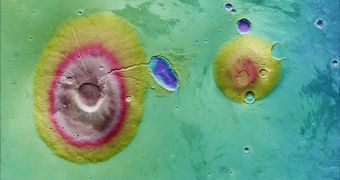While conducting investigations in the northern hemisphere of the Red Planet, the Mars Express orbiter imaged two neighboring volcanoes, that researchers say are evidence of the planet's geologically-active past. The spacecraft belongs to the European Space Agency (ESA).
Volcanic activity at the two mist-capped mountains has subsided billions of years ago, experts say. In the mean time, the entire region has been battered by large numbers of asteroid and meteorite impacts, which drastically changed is appearance.
All those impacts ejected large amounts of material from the surface, which then fell back under the action of gravity, and got deposited on the lower flanks of the two mountains. This gives them a very distinct look, experts say.
Mars Express collected the data used to create the new images between November 25, 2004 and June 22, 2006. ESA scientists then pieced together the information, until they finally got these products.
The orbiter was even able to identify icy clouds drifting atop one of the volcanoes, called Ceraunius Tholus. Planetary scientists were convinced that repeated orbiter passes above the region would not reveal any changes.
The base of the aforementioned volcano is about 130 kilometers across, and is shaped like a conical dome, hence the name. The mountain has a height of 5.5 kilometers, and features a 25-kilometer-wide caldera at its peak.
Its neighbor, called Uranius Tholus, is located about 60 kilometers to the north. Its base has a diameter of about 62 kilometers. The second mountain is also a bit shorter, reaching an altitude of only 4.5 kilometers.
“The largest and deepest of these valleys is about 3.5 km wide and 300 m deep. It terminates inside an otherwise unrelated elongated impact crater that happens to lie between the two volcanoes, and has created a fascinating fan shape of deposits,” ESA experts say in a press release.
“Although the source of the fan is still being debated in scientific circles, it may have been formed when material from a lava channel or tube was washed downwards by a melting ice cap on the volcano,” they go on to say.
The caldera atop Ceraunius Tholus, experts say, may have been a volcanic lake billions of years ago, when Mars' interior was still active, and tectonic processes were still unfolding.
The water may have been produced by volcanic eruptions that melted deposits of water-ice located under the Martian surface, as evidenced by the Phoenix Mars Lander.

 14 DAY TRIAL //
14 DAY TRIAL //